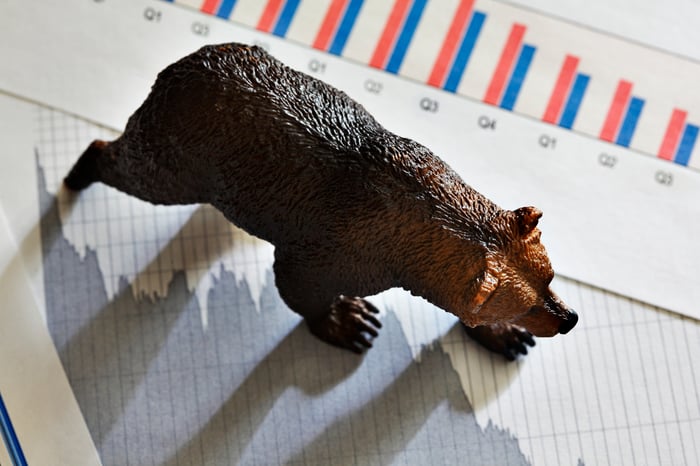As investors ready to ring in the new year, they have to be thrilled with Wall Street's performance in 2023. The iconic Dow Jones Industrial Average (^DJI 0.40%) recently climbed to a record high, with the benchmark S&P 500 (^GSPC 1.02%) and innovation-driven Nasdaq Composite (^IXIC 2.02%) gaining 25% and 44%, year to date, through the closing bell on Dec. 28.
But it's not about where Wall Street has been, so much as where the stock market is headed next. If there were such a thing as a perfect forecasting tool, everyone would be using it. Unfortunately, there isn't, which means the best we can do as investors is use a combination of history, macro and company-specific data, and our experience, to make predictions about the future.
What follows are 10 stock market predictions -- including macro predictions that can have bearing on the performance of equities -- for 2024.

Image source: Getty Images.
1. The U.S. economy will dip into a recession
To start with, the most-anticipated recession in U.S. history will finally take shape in the new year.
The Conference Board Leading Economic Index (LEI), which is comprised of 10 inputs and attempts to anticipate turning points in the business cycle, has declined for 19 consecutive months. With the exception of a 22-month decline from 1973-1975 and a 24-month tumble during the Great Depression, we've never seen a clearer sign that an economic slowdown is expected.
Following the money also offers a potentially chilling tale for Wall Street, at least in the very short term. Commercial bank credit has declined since mid-February, which signals that banks are purposefully tightening their lending standards.
Meanwhile, M2 money supply is notably falling for the first time since the Great Depression. Less available money for transactions has historically been a telltale sign that an economic downturn is on the horizon.
2. The bear market returns in 2024
Although the U.S. economy and stock market aren't tied at the hip, a downturn in the economy tends to have a negative impact on corporate earnings. History tells us that roughly two-thirds of the S&P 500's drawdowns since the start of the Great Depression in September 1929 have occurred after, not prior to, a recession being declared. In other words, if (key word!) a recession was to materialize, a bear market for stocks would probably follow.
S&P 500 Shiller CAPE Ratio data by YCharts.
Something else to consider is that stocks aren't cheap. The S&P 500's Shiller price-to-earnings ratio (also known as the "cyclically adjusted price-to-earnings ratio, or CAPE ratio) ended Dec. 28 at 32.36. That's about 90% higher than its average reading of 17.07, when back-tested 154 years.
Further, there have only been six instances since 1870 where the S&P 500's Shiller P/E surpassed 30. Following the previous five occasions, the broader market went on to lose between 20% and 89% of its value. While the Shiller P/E isn't a timing tool, it does suggest that extended periods of premium valuations aren't well-tolerated by Wall Street.
3. The second-longest yield-curve inversion on record will end
The yield curve, which is a chart depicting the yields of various Treasury debt securities relative to their maturity dates, has often been a tell of what's to come for the U.S. economy and stock market.
The US Yield Curve (10-year minus 3-month) has now been inverted for 427 consecutive days, the 2nd longest streak in history. Will likely become the longest inversion ever in February 2024. pic.twitter.com/l1q7cVMwSx
-- Charlie Bilello (@charliebilello) December 27, 2023
For the past 428 calendar days, as of Dec. 28, the yield curve that compares the 10-year Treasury bond to three-month Treasury bills has been inverted. This is to say that shorter-dated debt securities (i.e., the three-month bill) have higher yields than the longer-dated bond. While a yield-curve inversion doesn't guarantee that a U.S. recession is imminent, every recession since World War II has been preceded by an inversion.
Though the current inversion is likely to become the longest on record (currently 469 calendar days, set between Nov. 1965 and March 1967), it's unlikely to persist throughout the new year. With the nation's central bank expected to begin a rate-easing cycle, it wouldn't be surprising for the yield curve to normalize by year's end.
4. One of Wall Street's most-hated industries will thrive
If the Treasury yield curve inversion ends in 2024, highly interest-sensitive companies could benefit. This includes one of Wall Street's most universally disliked industries: mortgage real estate investment trusts (REITs).
Popular mortgage REITs like Annaly Capital Management (NLY 1.02%) and AGNC Investment (AGNC 0.97%) make their living by borrowing money at low short-term lending rates and use this capital to purchase higher-yielding long-term assets, such as mortgage-backed securities (MBSs). The greater the gap between the average yield on owned assets less average borrowing rate (this difference is known as "net interest margin"), the more profitable a mortgage REIT can be.
The yield-curve inversion has narrowed the net interest margin for mortgage REITs and made short-term borrowing costlier. But an end to this inversion, coupled with dovish Fed monetary policy, could make Annaly Capital Management and AGNC Investment absolutely sparkle in the eyes of income seekers.

Image source: Getty Images.
5. Core inflation will remain stubbornly high, if not reaccelerate
Most investors are likely thrilled with the Federal Reserve forecasting three rate cuts in 2024. When interest rates decline, it encourages companies to borrow, which can accelerate corporate hiring, fuel acquisition activity, and bolster innovation.
But there's another side to this coin. In recent memory, the Fed has cut rates in response to a growth slowdown. During the third quarter, the Bureau of Economic Analysis notes that U.S. gross domestic product increased by a red-hot 5.2%. With the nation's central bank planning to reduce rates in 2024, it risks reaccelerating the rate of inflation.
The core inflation rate, which removes volatile food and energy costs from the equation, could be particularly stubborn in 2024. A rapid uptick in mortgage rates has effectively frozen the housing market. Nothing short of a hard landing for the U.S. economy is likely to bring the core inflation down to the Fed's long-term target of 2%.
6. The artificial intelligence (AI) bubble will begin to burst
One of the primary catalysts that sent the S&P 500 and Nasdaq Composite screaming higher in 2023 is the rise of artificial intelligence (AI). AI, which involves the use of software and systems to handle tasks typically assigned to humans, can add nearly $16 trillion to the global economy by 2030, according to researchers at PwC.
However, history isn't on the side of AI's continued success -- at least in the short run. Every single next-big-thing investment trend over the past 30 years has gone through an initial bubble period. While many of these trends produced big-time winners over the long-term, the internet, business-to-business commerce, genomics, 3D printing, marijuana, blockchain technology, and the metaverse are just some of the examples of highly touted "new trends" that weren't initially given enough time to mature.
The potential bubble-popping event for AI could come from Nvidia (NVDA 6.18%), which has established itself as the infrastructure backbone of AI-accelerated data centers. Graphics processing unit (GPU) scarcity has sent Nvidia's pricing power on its A100 and H100 GPUs through the roof in 2023. But as production expands in the new year and competition picks up, Nvidia's pricing power and gross margin appear likely to take a hit.
7. Microsoft will surpass Apple to become the most-valuable public company
With few exceptions over the past decade, tech stock Apple (AAPL -0.35%) has been the world's largest publicly traded company by market cap. Apple's innovation has been the driving force behind its success. It remains the leading smartphone company by market share in the U.S., and its subscription services segment is rapidly evolving.
But when examined as a whole, Apple's growth engine has stalled. All of the company's physical products endured sales declines in fiscal 2023 (ended Sept. 30, 2023). While a greater than $600 billion share repurchase program since the start of 2013 has helped lift the company's earnings per share, it's no longer the growth story it once was.
With Apple failing to deliver in the growth department, it's Microsoft (MSFT 1.82%) that stands ready to ascend to the top of the pedestal. Microsoft Azure accounted for 25% of global cloud infrastructure service spending during the third quarter, according to Canalys. The company is also benefiting from the abundant cash flow of its legacy operations (e.g., Windows and Office), and its steady stream of acquisitions. Microsoft has the necessary catalysts to become the world's most-valuable public company in 2024.
8. Tesla will fall below $100 per share
Keeping with the theme of Wall Street's most-important and widely owned companies, I fully expect the world's largest electric vehicle (EV) maker by market cap, Tesla (TSLA -1.11%), to fall below $100 per share in the new year. For context, Tesla shares closed at roughly $253 with one trading day left in 2023.
Tesla's pricing strategy is a potentially major red flag. During the company's annual shareholder meeting in May, CEO Elon Musk noted that Tesla's pricing strategy is based on demand. With the company slashing prices on Model's 3, S, X, and Y on more than a half-dozen occasions in 2023, it pretty clearly signals that demand is faltering, inventory levels are rising, and competition is picking up. Tesla's once superior operating margin is now on-par with the auto industry average.
Furthermore, Elon Musk continues to be a tangible risk for Tesla's shareholders. Despite being a visionary, he frequently overpromises and underdelivers when it comes to new innovations. Though Tesla is valued as a do-it-all company in the energy and auto space, it generates the bulk of its profit from selling and leasing EVs (the auto industry usually sports single-digit earnings multiples), and is reliant on unsustainable sources of income for a sizable percentage of its profit.
9. Utilities will be a top-3 sector in 2024
Next up is the prognostication that the worst-performing sector for the S&P 500 in 2023 will be one of the three best-performing sectors in the new year. I'm talking about utilities.
Most investors flock to utility stocks because of their low volatility, market-topping dividends, and predictable operating performance. But with Treasury yields soaring in response to the Fed's aggressive rate-hiking cycle, investors bid adieu to utilities and opted to purchase Treasury bonds instead. This led to a very poor year for a traditionally safe sector.
But with the central bank looking to ease interest rates in 2024, utilities are back on the radar as a potential outperformer. The dividend yields of utilities should become more attractive as Treasury bond yields decline. Further, access to cheaper borrowing rates may fuel acquisitions and major projects that ultimately lift growth rates for the sector's major players -- I'm looking at you, NextEra Energy.
10. A short-lived "crisis" will take shape
Last but not least is the prediction that an unforeseen event will, at least temporarily, weigh down Wall Street.
Almost every year features an unexpected event that wreaks havoc on the Dow, S&P 500, and Nasdaq Composite. For instance, 2023 saw the short-lived regional banking crisis threaten the fabric of the financial system. The failure of three sizable banks created ripples throughout the financial sector that had investors questioning the solvency of rock-solid banking institutions.
In 2022, Russia's invasion of Ukraine served as the year's tumultuous event. The geopolitical implications of Russia's invasion led to a short-term malaise for equities.
Though it's impossible to predict what short-term crisis might unfold in 2024, the best guess I can offer is a housing price collapse, or perhaps a wave of auto loan defaults.
Only time will tell if this or any of these predictions comes to fruition in the new year.







